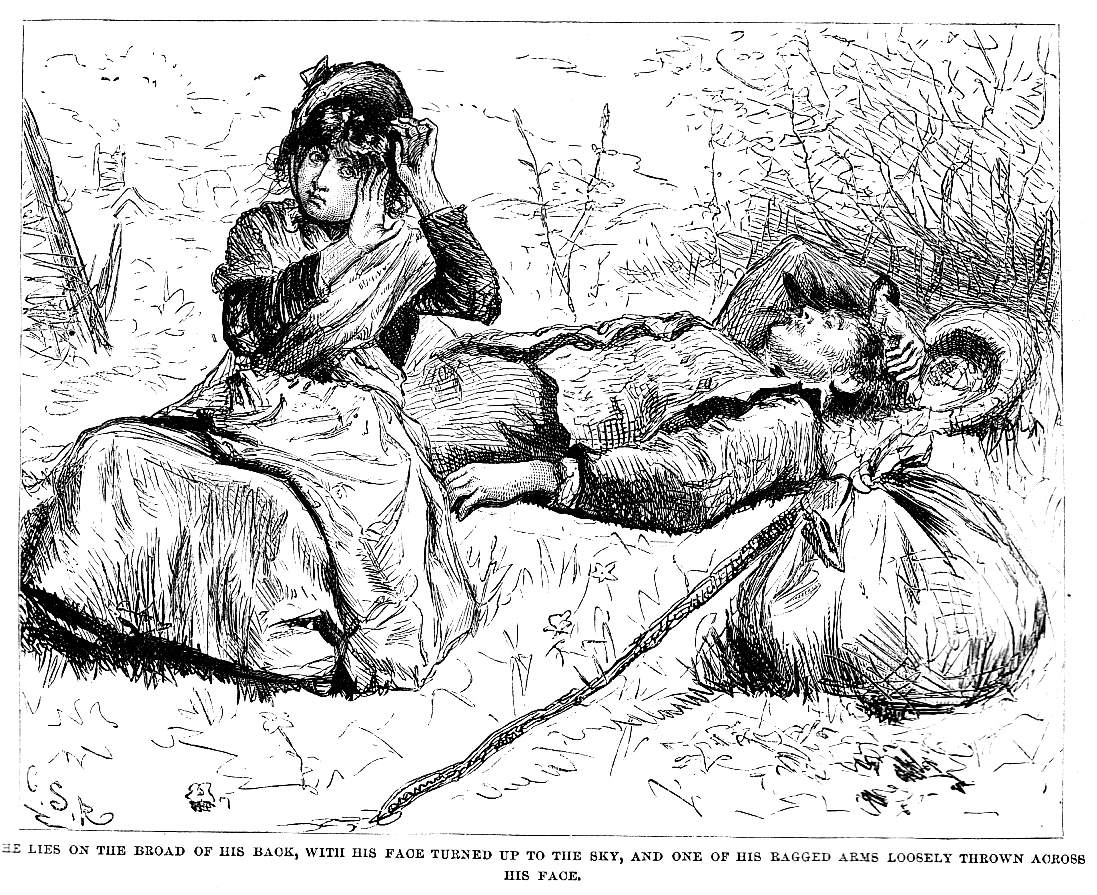
He lies on the broad of his back, with his face turned up to the sky, and one of his ragged arms loosely thrown across his face by Charles S. Reinhart (1844-96). 10.2 cm high by 13.3 cm wide (half-page, horizontally mounted in the middle of 49). [Click on image to enlarge it.]
The wood-engraving illustrates a scene on page 48 in "Tramps," the eleventh chapter in Charles Dickens's The Uncommercial Traveller, this essay having first appeared in All the Year Round on 16 June 1860. The American Household Edition, also containing Reinhart's wood-engravings for Hard Times (1854) and Fildes' for The Mystery of Edwin Drood (1870), was published by Harper and Brothers in 1876.
Passage Illustrated
Whenever a tramp sits down to rest by the wayside, he sits with his legs in a dry ditch; and whenever he goes to sleep (which is very often indeed), he goes to sleep on his back. Yonder, by the high road, glaring white in the bright sunshine, lies, on the dusty bit of turf under the bramble-bush that fences the coppice from the highway, the tramp of the order savage, fast asleep. He lies on the broad of his back, with his face turned up to the sky, and one of his ragged arms loosely thrown across his face. His bundle (what can be the contents of that mysterious bundle, to make it worth his while to carry it about?) is thrown down beside him, and the waking woman with him sits with her legs in the ditch, and her back to the road. She wears her bonnet rakishly perched on the front of her head, to shade her face from the sun in walking, and she ties her skirts round her in conventionally tight tramp-fashion with a sort of apron. You can seldom catch sight of her, resting thus, without seeing her in a despondently defiant manner doing something to her hair or her bonnet, and glancing at you between her fingers. She does not often go to sleep herself in the daytime, but will sit for any length of time beside the man. And his slumberous propensities would not seem to be referable to the fatigue of carrying the bundle, for she carries it much oftener and further than he. [Chapter 11, "Tramps," p. 48]
Commentary
Reinhart's approach to the chapter on "Tramps" in the Kentish countryside is very different from that of Dalziel's "'Then you're a tramp,' he ses. 'I'd rather be that than a beadle,' I ses." Whereas Dalziel's illustration shows the similarity between the Beadle and the tramp in spite of their differences in costume and social station, Reinhart captures a pastoral idyll, with the young man's attractive common-law wife adjusting her hair as the pair lie in a glade at the side of the high road to escape the heat of the day. The substantial bundle, amounting to the couple's luggage, appears enormous; indeed, it is almost a third person in the picture. In place of Dalziel's dark, heavy lines and stolid characters Reinhart delicately sketches in his animated figures, revealing an eye for beauty in his graphic realization of the young woman, captured in movement rather than in a static pose, which is Dalziel's consistent preference. The charming illustration, focussing not on the sleeping tramp but his female companion, bears out the truth of Henry James's observation that Reinhart, as opposed to revelling in rendering a dramatic situation, "likes to represent character — he rejoices in the specifying touch" (74).
Scanned image and text by Philip V. Allingham [You may use this image without prior permission for any scholarly or educational purpose as long as you (1) credit the photographer and (2) link your document to this URL in a web document or cite the Victorian Web in a print one.]
Bibliography
Bentley, Nicolas, Michael Slater, and Nina Burgis. The Dickens Index. New York and Oxford: Oxford U. P., 1990.
Dickens, Charles. The Uncommercial Traveller, Hard Times, and The Mystery of Edwin Drood. Il. Charles Stanley Reinhart and Luke Fildes. The Household Edition. New York: Harper and Brothers, 1876.
Dickens, Charles. The Uncommercial Traveller. Il. Edward Dalziel. The Household Edition. London: Chapman and Hall, 1877.
Picture and Text. New York: Harper and Brothers, 1893. Pp. 61-78.
Scenes and Characters from the Works of Charles Dickens; being eight hundred and sixty-six drawings, by Fred Barnard, Hablot Knight Browne (Phiz); J. Mahoney; Charles Green; A. B. Frost; Gordon Thomson; J. McL. Ralston; H. French; E. G. Dalziel; F. A. Fraser, and Sir Luke Fildes; printed from the original woodblocks engraved for "The Household Edition." New York: Chapman and Hall, 1908. Copy in the Robarts Library, University of Toronto.
Slater, Michael, and John Drew, eds. Dickens' Journalism: 'The Uncommercial Traveller' and Other Papers 1859-70. The Dent Uniform Edition of Dickens' Journalism, vol. 4. London: J. M. Dent, 2000.
Created 10 April 2013
Last modified 6 January 2020